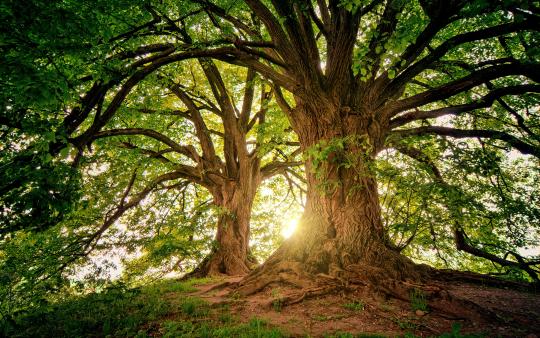Leading forest ecologist Suzanne Simard believes that there is plenty to learn about how trees help each other and the world around them. In her groundbreaking New York Times bestseller, Finding the Mother Tree: Discovering the Wisdom of the Forest,¹ mysteries that promise to increase our understanding of the connectivity and generosity of trees, and their role in slowing climate change.
The Forest for the Trees
Simard shares her life and experiences as she weaves her journey of discovery through the stories of the trees. After decades spent researching Indigenous knowledge and scientific study, and immersing herself in North America’s rugged forests and the scarred remnants of clearcut logging, she developed sensitive experiments designed to show the connectivity of the forest. Simard concludes that, “Mother Trees—the majestic hubs at the centre of forest communication, protection, and sentience, are vital to any healthy forest.” They are not solitary beings: they are linked together by the wood wide web: a vast underground fungal network. Simard’s research has shown that a Mother Tree can be connected to hundreds of other trees. They are able to recognize their own seedlings and will prioritize their own kin over others by providing them with more nutrients. On a wider scale, trees in a forest work together as one. In a series of experiments, Simard was able to document how a Douglas fir transmitted a signal through the mycorrhizal network warning a neighbouring Ponderosa pine about a nearby spruce budworm infestation. The pines were able to amp up production of defence enzymes against the invaders.
Extended Family Trees
Now a professor in the Department of Forest and Conservation at the University of British Columbia, Simard started her quest to understand trees as a child in the old-growth forests of B.C.’s Monashee Mountains, where she and her siblings had once explored the woods, collected berries and mushrooms, and built forts and tree swings. Simard believes that engaging in nature is what our children need, especially now. After all, when children are introduced to the wonders of nature and concepts like forests as communities, they are better prepared to engage in problem-solving, take action, and help the world. Simard says, “I think the main thing is to try and teach kids that forests are societies like our own families and communities.”
“You can get kids to imagine the relationships between the big trees and the little trees and maybe which little trees are friends with each other,” she explains. “When children can relate a forest to their own friendships and family relationships, then they will better understand that forests are connected and we are connected to nature as well.” Simard goes further to suggest that trees can also learn, remember, and make decisions. By perceiving trees as possessing qualities we normally ascribe to intelligence and generosity, are we more willing to protect them? “I believe this kind of transformative thinking is what will save us. It is a philosophy of treating the world's creatures and its gifts, of equal importance to us,” says Simard. Children are growing up in a world of rapidly escalating climate change, partially fuelled by massive deforestation. What if the next time you took your children for a walk in the woods, you looked for Mother Trees?
Unbe-leaf-able Trees
Simard shows us that forests are so much more than a collection of individual trees competing with one another for resources. If Mother Trees just looked out for themselves, the forest wouldn't survive. There is a bigger lesson here for all of us, which is, without cooperation and communication we can’t survive. This type of revolutionary science is turning our ideas about trees upside down, and it’s catching on. People everywhere are connecting with her findings. Parents and teachers are sharing these ideas with children, Simard’s work has already influenced James Cameron's film Avatar (Tree of Souls) and a character in Richard Powers’ book The Overstory is based on Simard. Recently, her academic work was mentioned on the hit show Ted Lasso and her journey was so inspiring that Amy Adams and Jake Gyllenhaal just bought the movie rights to Simard’s book. Adams is set to play Simard in the feature film. “We have the power to shift course. It’s our disconnectedness— and lost understanding about the amazing capacities of nature— that’s driving a lot of our despair…” Simard says. “By understanding their sentient qualities, our empathy and love for trees, plants, and forests will naturally deepen and we’ll find innovative solutions. Turning to the intelligence of nature itself is the key. It’s up to each and every one of us.”
Finding the Mother Tree: Discovering the Wisdom of the Forest is a call to action we need now. I love this book and I love trees!

6 Fun Family-Friendly Forest Walk Activities
Every walk in the forest is an invitation for children and teens to understand emerging forest science and connect with the wonders of nature.
1. Play ‘Find the Mother Tree’
Mother Trees connect the forest. Can you find one? “Look for the largest, oldest trees in the forest,” Simard says. They can be any species, but will have the biggest crowns and the most leaves so they are capable of more photosynthesis (the process by which plants make energy and absorb carbon dioxide). Mother Trees also have the largest root systems, so they can reach out and help feed the rest of the forest. “They are connected to more trees, the sheer energy moving through those massive trees with their huge photosynthetic capacity makes them the nucleus of the forest. They are feeding the energy into the forest more than anything else,” Simard explains. Can you imagine tapping into her roots and linking into the wood wide web to help support other nearby trees?
2. Giving trees
Trees do much to help the world: They store carbon, improve soil and water conservation, provide shade and homes for people and animals, boost the earth’s capacity to adapt to climate change, and so much more. Hug a tree and say thank you for this extraordinary generosity!
3. Be a forest detective
Go find a tree that you feel drawn to and explore it. Listen to the sounds around it, take in the sights and smells of this part of the forest, touch the bark and leaves, and follow the roots across the forest floor. Are there any animals living in your tree? Can you sense your tree talking to other trees through the wood wide web? Collect leaves or pine cones and take photos and notes about your observations.
4. Hear a call to action
Discuss how you can help support individuals, environmental education, and conservation groups working to protect forests and expand our scientific knowledge about trees. Make a plan with your parents or teachers and take action.
5. Plant a tree
Consult a parent, teacher, or forest ecologist for advice about local planting species and locations to give your tree the best opportunity to thrive. Plant it and return often to visit and care for it.
6. Read a book about trees under a tree
Here are just a few of the many tree-mendous tree books for kids to take on your forest adventure:
- Ultimate Explorer Field Guide: Trees (National Geographic Kids)
- Can You Hear the Trees Talking?: Discovering the Hidden Life of the Forest
- The Magic and Mystery of Trees
- The Wish Trees: How Planting Trees Can Help Make the World a Better Place
- The Wisdom of Trees: How Trees Work Together to Form a Natural Kingdom
For references visit ecoparent.ca/EXTRAS/SPR22.
You may also enjoy: Back to Nature: Understanding Nature Immersion Therapy, How Nature Therapy Helps Children Heal, and Rethinking Environmental Education, Reconciling with the Natural World.





